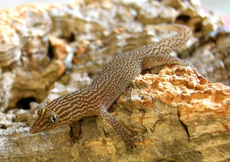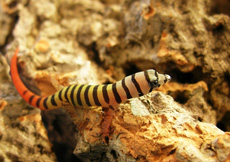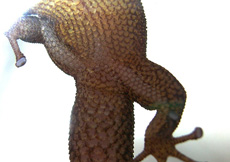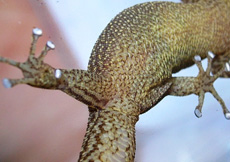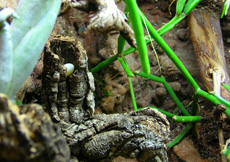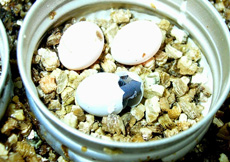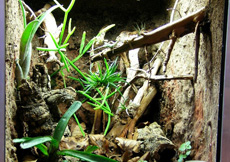Sphaerodactylus elegans
(MACLEAY, 1834)
Distribution:
Cuba and offshore islands, the entire Haitian part of Hispaniola, locally in the Dominican Republic, Ile de la Gonâve, Ile Grande Cayemite and introduced to Florida
Description:
Sphaerodactylus elegans has an overall length of about 7 centimeters, it is one of the larger members of the genus Sphaerodactylus. The head is pointed and the eyes can move independently from one another, above these the Cilary scales can be seen. On their feet as with all Sphaerodactylus besides claws are adhesive pads that allow them to run well on smooth surfaces. In this species the sexes do not differ in their coloration. The body of Sphaerodactylus elegans has a red-brown base color, with beige wandering lines and dots. From the base of the tail the pattern is usually the other way around with a beige base color and red-brown zig zags. The ventral side is gray-white. Sphaerodactylus elegans males are typically identified by their Escutcheon. The coloration of the juveniles differs completely from the adults. Up to the age of about three months they are beige striped with black at the tail this changes into red.
With Sphaerodactylus elegans two subspecies are described: the nominate form, Sphaerodactylus elegans elegans, which has its habitat in Cuba. The other subspecies is Sphaerodactylus elegans punctatissimus (Duméril & Bibron 1834) from Haiti. The latter subspecies remains on average 1-2mm smaller and often retains slight banding from youth. Unless you know the exact location from where your animals come from it is not possible to tell the exact subspecies because of very little variation between them.
Often you see pictures and information about Sphaerodactylus elegans in books and the internet which are mistakenly referred to as Sphaerodactylus cinerus. Sphaerodactylus cinerus is however a separate species and only the males slightly resemble Sphaerodactylus elegans.
Habitat:
Sphaerodactylus elegans has settled in the nature in open, dry to semi-wet areas. The animals are ground dwellers and thus can be found under woody debris, stones, cut plant parts or discarded garbage. As synanthropic animals they can be found on houses and on walls, sometimes even in homes, behind pictures and cabinets. They lead a hidden life and usually only look out with their head from their hideout. With the slightest disturbance they retreat "elegantly" back. Their main activity is in the late afternoon into the evening. In the morning they come out of hiding briefly to warm up in the sunshine to their preferred temperature.
Husbandry and Breeding:
The keeping and breeding of Sphaerodactylus elegans is very easy, if one considers a few basic needs. Due to their small body size, the terrarium does not need to be very large. For example you can keep a pair in a terrarium measuring 25x40x30 centimeters with no problem. The substrate should consist of sand or a sand-soil mixture which must be kept slightly moist at all times. The side and rear walls should be covered so the animals are not easily stressed out. If the walls are decorated with natural cork or cork tiles, etc the animals have the opportunity to retreat to the back of the terrarium and remain undisturbed. The terrarium should consist of additional hiding places in the form of cork tubes, branches or dry leaves. Natural vegetation also helps to offer a visually appealing terrarium. Such plants as different trailing plants, bromeliads, orchids or epiphytic cactus in the genus Rhipsalis and Hatiora may be used. A small water bowl and a bowl of crushed up cuttlefish bone are a must in completing the setup.
The terrarium should be illuminated for 12 hours a day with 1-2 fluorescent tubes, additionally a halogen puck light which is switched on for two hours daily. Following these requirements, the lighting should provide the necessary temperature of 24-28°C (75-82°F). In winter the illumination is reduced to 10 hours per day which should drop the temperatures down two to four degrees daily, with night time drops to 18°C (64°F). Reducing the temperatures in winter helps females recover from the stress of egg laying. To achieve a relative humidity of about 70% the terrarium should be misted daily. The should be fed every 3 days with appropriate sized food. Suitable feeders are small crickets, woodlice, firebrats, springtails, small wax moths, fruit flies and aphids, to name a few.
After a successful mating the females of Sphaerodactylus elegans lay a single egg every 3 weeks in a suitable location. We have found the eggs under bark, between plant parts or under the leaf litter. For better control it is advisable to remove the eggs and transfer them into an incubator. At incubation temperatures of 28°C (82°F) the hatchling emerges between 80-90 days measuring 3.2 centimeters. These can be housed individually or in small groups of 2-3 animals in 1.3 liter household container. Sphaerodactylus elegans hatchlings fair very good with equal-sized hatchlings of other species and genera, such as for example, a member of the genus Gonatodes. The rearing boxes should contain substrate, a small climber and a piece of bark to hideout in. It is illuminated with a fluorescent tube, which also provides the necessary warmth. To meet the water requirements of the young animals the container should be misted daily. They should be fed every 2-3 days with springtails, small firebrats and micro crickets for example. At 3 months of age the animals start to change their coloration and at about 5 months they have the same coloring as their parents. Sphaerodactylus elegans sexually matures at around 10-12 months.
Sphaerodactylus elegans is a very interesting terrarium specimen, which spends its time in the evenings out in the open so it can be easily observed. Because of their young and adult size, as well as its availability, it is one of the dwarf geckos recommended for a beginner.
